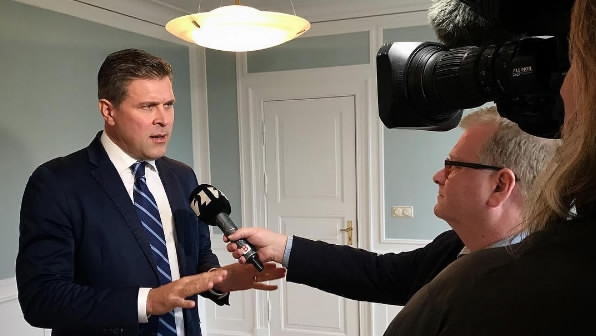
Politics
18:40, 27-Oct-2017
Snap Iceland poll crackles after slew of scandals
By John Goodrich

Iceland, famed for stunning scenery, noir literature and a dramatic financial meltdown, is fast becoming a land of political intrigue.
Residents of the picturesque island in the North Atlantic will go to the polls on Saturday in a closely-contested snap parliamentary election -- the second within one year after a string of scandals.

The country is booming on the back of a 266-percent rise in tourism over the past six years, after being hit hard during the 2008 financial crisis.
But the legacies of that near economic collapse live on, with top figures hit by accusations of financial misdeeds and anti-establishment parties attracting strong support.
Why was the election called?
Prime Minister Bjarni Benediktsson called the election in September when the coalition government, led by his Independence Party, collapsed less than a year after being formed.
Bright Future, a junior member of the three-party center-right coalition quit citing a “serious breach of trust”, following allegations that the Independence Party tried to cover up a letter written by the prime minister's father in a bid to reinstate the rights of a convicted pedophile.

Independence Party leader Bjarni Benediktsson. /Independence Party Photo
Independence Party leader Bjarni Benediktsson. /Independence Party Photo
People who commit serious crimes in Iceland can have their “civil standing” restored if they fulfill certain requirements, including receiving letters of recommendation.
The previous government fell apart over a financial scandal, an issue that has also dogged Benediktsson and has roots in 2008 when Iceland’s three major banks collapsed and were nationalized -- and the country teetered on the verge of bankruptcy.
Crisis and rebound
Iceland’s stock market plummeted by over 90 percent in 2008 and the value of the krona halved, but the economy has bounced back sharply since.
International Monetary Fund support and government measures helped achieve stability, and a tourism boom has propelled it forward. It returned to growth in 2011, and GDP expanded by 7.2 percent in 2016.

The Northern Lights over Mount Kirk, Iceland. /VCG Photo
The Northern Lights over Mount Kirk, Iceland. /VCG Photo
The overall number of tourists flying or cruising into Reykjavik rose by 266 percent between 2010 and 2016, including a huge 1,185-percent surge in Chinese visitors in the same period hoping for a glimpse of the Northern Lights.
However, the increase in tourism has come with costs. There were more US visitors to Iceland than there were Icelanders in 2016, and the tranquil beauty of the glaciers is increasingly interrupted by coach parties.
Who are the contenders?
The Independence Party was part of every government from 1980 to 2009 and has been in power since 2013 -- the most recent polling suggests that it will again be the biggest party.
Benediktsson’s party sits on 24 percent, according to a poll published on Thursday by Frettabladid, Iceland's largest newspaper. Despite the scandals, the prime minister has delivered high growth and low unemployment. He has campaigned on the promise of stability and tax cuts.

Left-Green Party leader Katrín Jakobsdóttir. /Left-Green Party Photo
Left-Green Party leader Katrín Jakobsdóttir. /Left-Green Party Photo
The Left-Greens, led by 41-year-old Katrín Jakobsdóttir, is the leading opposition party at 19 percent. It has argued for tax rises for the rich, as well as measures to tackle inequality and make Iceland carbon neutral. However, the country has had only one left-wing government since it gained independence from Denmark in 1944.
The Social Democrats stand at 14.3 percent in the latest poll, a significant uptick from the 5.7 percent achieved in the previous snap election on October 29, 2016.

Reykjavik, Iceland's capital. /VCG Photo
Reykjavik, Iceland's capital. /VCG Photo
The anti-establishment Pirate Party, which won 14.5 percent of votes in 2016 to become the third biggest party, stood at nine percent in Thursday's poll.
Other parties in contention to win seats include the coalition partners in the previous government -- Reform and Bright Future -- plus the Progressives, People’s Party, and Centre, a new party led by former prime minister Sigmundur Davíð Gunnlaugsson.
How does the election work?
Sixty-three seats are up for grabs in the parliament, the Althing, and 682 men and 562 women are competing for places.

Iceland's parliament, the Althing. /VCG Photo
Iceland's parliament, the Althing. /VCG Photo
The seats are spread across six constituencies and assigned using proportional representation. Parties that receive at least five percent of the national vote are eligible for a share of nine further seats.
The president traditionally asks the leader of the biggest party to try to form a coalition government.
Whether a viable coalition can be formed in a system with proportional representation and nine competitive parties remains to be seen.
7892km

SITEMAP
Copyright © 2018 CGTN. Beijing ICP prepared NO.16065310-3
Copyright © 2018 CGTN. Beijing ICP prepared NO.16065310-3